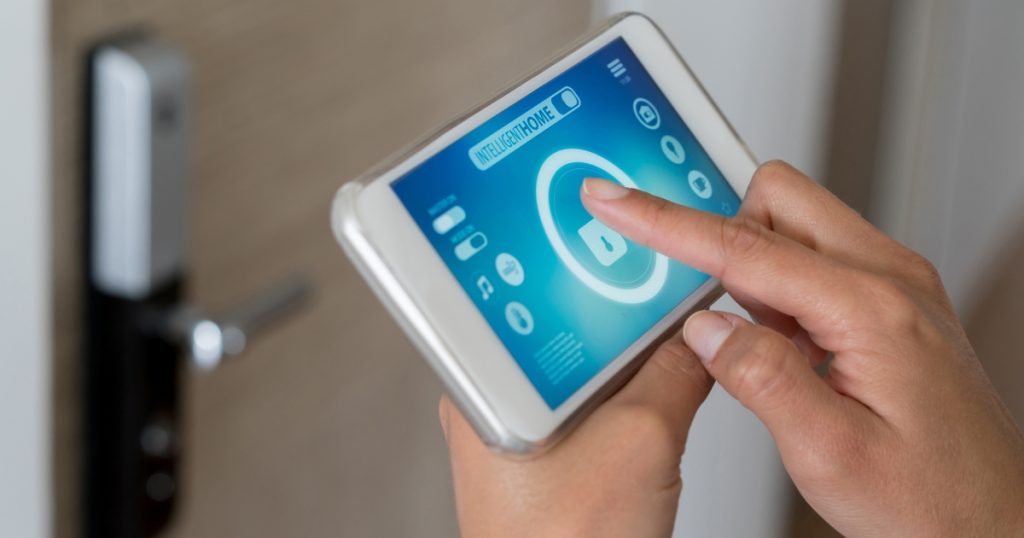The traditional method of securing our homes with physical keys has long been the norm. However, with advancements in technology and the need for improved security measures, the advent of smart locks has revolutionised the way we protect our homes.
In this comprehensive guide, we will explore the world of smart locks and delve into their features, benefits, and potential drawbacks.
We will also discuss the best smart locks on the market and how they can transform your home into a keyless haven.
What are Smart Locks?
Smart locks are advanced electronic locking systems that provide enhanced security and convenience for your home. These innovative devices allow you to lock and unlock your doors using a smartphone, a key fob, or even biometric data like fingerprints.
Smart locks not only offer keyless entry but also provide remote access, giving you the ability to control your locks from anywhere in the world.
A Brief History of Smart Locks
The concept of smart locks can be traced back to the early 2000s when electronic key cards were first introduced in commercial buildings and hotels. Over time, this technology has evolved and become more sophisticated, leading to the development of residential smart locks.
The first generation of smart locks relied on Bluetooth technology and required close proximity for access. As technology improved, smart locks began incorporating Wi-Fi and other wireless protocols, providing users with greater flexibility and control.
The Advantages of Smart Locks
There are several benefits to installing smart locks in your home, including:
- Enhanced security: Smart locks utilise advanced encryption methods and multiple authentication layers, making them more secure than traditional locks.
- Keyless entry: With smart locks, you no longer need to carry keys, reducing the risk of losing them or having them stolen.
- Remote access: You can lock or unlock your doors from anywhere in the world using your smartphone or other connected devices.
- Temporary access: You can grant temporary access to guests, service providers, or family members without having to make physical keys.
- Activity monitoring: Many smart locks have built-in activity logs, allowing you to monitor who enters and exits your home and when.
The Disadvantages of Smart Locks
Despite their many advantages, smart locks also have some potential drawbacks, including:
- High upfront cost: Smart locks can be more expensive than traditional locks, especially if you opt for a model with advanced features.
- Compatibility issues: Some smart locks may not be compatible with your existing door hardware, requiring additional modifications or replacements.
- Technology reliance: Smart locks rely on technology, which can sometimes fail or be vulnerable to hacking.
- Battery dependency: Most smart locks are powered by batteries, which need to be replaced regularly to ensure continued functionality.
- Privacy concerns: Some users may feel uneasy about the potential for data breaches and the sharing of personal information with third parties.
Types of Smart Locks
There are several types of smart locks available, each with its unique features and capabilities. The most common types include:
Bluetooth Smart Locks
Bluetooth smart locks use short-range wireless communication to connect with your smartphone or other Bluetooth-enabled devices. These locks typically require you to be within a certain range (usually around 30 feet) to unlock your door. Bluetooth smart locks are a popular choice due to their ease of use and relatively low cost compared to other smart lock types.
Wi-Fi Smart Locks
Wi-Fi smart locks connect to your home’s Wi-Fi network, allowing you to control your locks remotely from anywhere with an internet connection. These locks offer greater flexibility and control, as they enable you to grant temporary access, monitor activity, and receive notifications when your door is locked or unlocked. However, Wi-Fi smart locks can be more expensive and may require a separate hub or bridge for connectivity.
Z-Wave Smart Locks
Z-Wave smart locks use a low-power wireless protocol designed specifically for home automation. These locks require a Z-Wave-compatible hub to connect with your smartphone or other devices. Z-Wave smart locks offer many of the same features as Wi-Fi smart locks but generally have a longer battery life and can integrate more seamlessly with other smart home devices.
Biometric Smart Locks
Biometric smart locks use your unique biological characteristics, such as fingerprints or facial recognition, to unlock your door. These locks offer a high level of security and convenience, as they eliminate the need for keys or access codes. However, biometric smart locks can be more expensive and may require regular software updates to maintain accuracy.
How to Choose the Right Smart Lock for Your Home
When choosing a smart lock, consider the following factors:
Compatibility
Ensure that the smart lock you select is compatible with your existing door hardware and can be installed without significant modifications. Additionally, consider whether the smart lock will integrate with your existing smart home ecosystem.
Features
Evaluate the features offered by each smart lock, such as remote access, activity monitoring, and temporary access capabilities. Consider which features are most important to you and select a lock that meets your needs.
Security
Research the security protocols and encryption methods used by each smart lock to ensure that your home will be adequately protected. Look for locks that offer multiple layers of authentication and strong encryption standards.
Price
Compare the prices of different smart locks and weigh the costs against the features offered. While it may be tempting to opt for the least expensive option, keep in mind that investing in a high-quality smart lock can provide long-term security and convenience benefits.
Top 5 Smart Locks for a Keyless Home
Here are five of the best smart locks on the market, offering a range of features, security, and compatibility options:
August Wi-Fi Smart Lock
The August Wi-Fi Smart Lock is a popular choice due to its sleek design, compatibility with most standard deadbolts, and seamless integration with various smart home platforms. This lock offers remote access, activity monitoring, and temporary access features, as well as integration with popular voice assistants such as Alexa, Google Assistant, and Siri.
The August Wi-Fi Smart Lock also includes DoorSense technology, which alerts you if your door is left open or unlocked.
Yale Assure Lock SL
The Yale Assure Lock SL is a keyless touchscreen smart lock that offers both Wi-Fi and Z-Wave connectivity options. With its sleek design and compatibility with various smart home platforms, this lock provides a high level of security and convenience.
The Yale Assure Lock SL allows you to create up to 250 unique access codes and integrates with voice assistants like Alexa, Google Assistant, and Siri.
Schlage Encode Smart WiFi Deadbolt
The Schlage Encode Smart WiFi Deadbolt is a Wi-Fi-enabled smart lock that offers a high level of security and a range of advanced features. With its built-in alarm technology, this lock can detect potential security threats and alert you accordingly.
The Schlage Encode also supports up to 100 unique access codes, integrates with popular smart home platforms, and is compatible with various voice assistants.
Kwikset Kevo Convert
The Kwikset Kevo Convert is a Bluetooth-enabled smart lock that transforms your existing deadbolt into a smart lock without requiring a complete replacement. The Kevo Convert is easy to install and offers keyless entry, activity monitoring, and remote access features when used with the optional Kevo Plus hub.
This lock is compatible with various smart home platforms and can be controlled using your smartphone or a compatible key fob.
Ultraloq U-Bolt Pro
The Ultraloq U-Bolt Pro is a versatile smart lock that offers multiple entry methods, including fingerprint recognition, keypad access, smartphone control, and a mechanical key backup. With its dual data encryption and anti-peep keypad technology, this lock provides a high level of security for your home.
The Ultraloq U-Bolt Pro also features auto-lock and auto-unlock capabilities and can be controlled remotely with the optional Wi-Fi bridge.
Installation and Maintenance of Smart Locks
Installing a Smart Lock
Installing a smart lock typically involves the following steps:
- Remove your existing lock and deadbolt hardware.
- Install the new smart lock, following the manufacturer’s instructions. This may involve attaching a mounting plate, installing the lock mechanism, and connecting any necessary wiring.
- Set up the smart lock on your smartphone or other connected devices, following the manufacturer’s instructions for pairing and configuring the lock.
- Test the smart lock to ensure proper functionality and adjust settings as needed.
Maintaining Your Smart Lock
To ensure the continued performance and longevity of your smart lock, follow these maintenance tips:
- Regularly check the battery level and replace batteries as needed. Most smart locks will notify you when the battery is low.
- Keep the lock and surrounding door hardware clean and free of debris.
- Periodically update the software and firmware on your smart lock to ensure optimal performance and security.
- Test the lock’s functionality and settings regularly to identify and address any potential issues.
Frequently Asked Questions About Smart Locks
Are smart locks safe?
While no lock can provide absolute security, smart locks generally offer a high level of protection due to their advanced encryption methods and multiple authentication layers. To ensure the safety of your smart lock, choose a reputable brand and model with strong security features.
Can smart locks be hacked?
Like any technology, smart locks can potentially be hacked. However, the risk can be minimised by selecting a smart lock with strong security protocols, encryption methods, and regular software updates.
Additionally, you can take steps to protect your home network and connected devices by using strong passwords, enabling two-factor authentication, and keeping your software up to date.
Do smart locks work during power outages?
Most smart locks are battery-operated and will continue to function during power outages. However, certain features that rely on Wi-Fi connectivity or your home’s power supply, such as remote access or integration with other smart home devices, may be temporarily unavailable during an outage. Some smart locks also offer mechanical key backups, providing an additional entry option in case of a power outage or battery failure.
Conclusion
Smart locks offer a convenient and secure alternative to traditional locks, providing keyless entry, remote access, and advanced security features for your home.
By understanding the different types of smart locks available and carefully considering your specific needs and preferences, you can select the perfect smart lock for your keyless home.
Investing in a smart lock can not only enhance the security of your home but also simplify your daily life, granting you greater control and peace of mind.
With a wide range of models and features to choose from, there is a smart lock out there that will perfectly suit your needs and seamlessly integrate into your connected home ecosystem.

